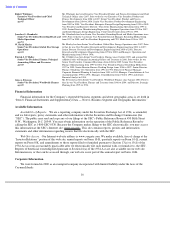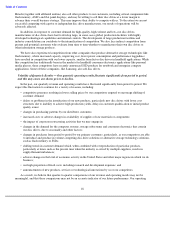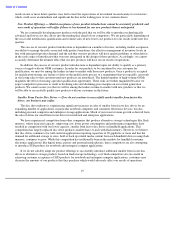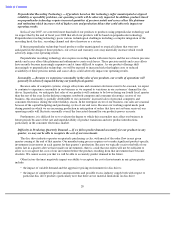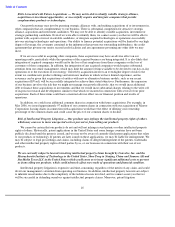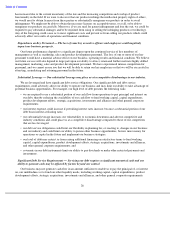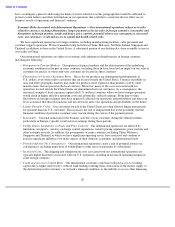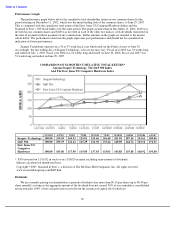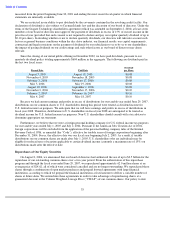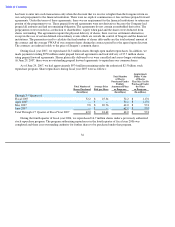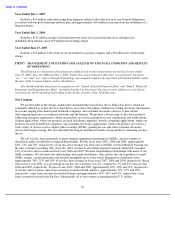Seagate 2006 Annual Report Download - page 29
Download and view the complete annual report
Please find page 29 of the 2006 Seagate annual report below. You can navigate through the pages in the report by either clicking on the pages listed below, or by using the keyword search tool below to find specific information within the annual report.
Table of Contents
has increased due to the current uncertainty of the law and the increasing competition and overlap of product
functionality in the field. If we were to discover that our products infringe the intellectual property rights of others,
we would need to obtain licenses from these parties or substantially reengineer our products in order to avoid
infringement. We might not be able to obtain the necessary licenses on acceptable terms, or at all, or be able to
reengineer our products successfully. Moreover, if we are sued for patent infringement and lose the suit, we could be
required to pay substantial damages and/or be enjoined from using or selling the infringing products or technology.
Any of the foregoing could cause us to incur significant costs and prevent us from selling our products which could
adversely affect our results of operations and financial condition.
Dependence on Key Personnel — The loss of some key executive officers and employees could negatively
impact our business prospects.
Our future performance depends to a significant degree upon the continued service of key members of
management as well as marketing, sales and product development personnel. The loss of one or more of our key
personnel would have a material adverse effect on our business, operating results and financial condition. We believe
our future success will also depend in large part upon our ability to attract, retain and further motivate highly skilled
management, marketing, sales and product development personnel. We have experienced intense competition for
personnel, and we cannot assure you that we will be able to retain our key employees or that we will be successful in
attracting, assimilating and retaining personnel in the future.
Substantial Leverage — Our substantial leverage may place us at a competitive disadvantage in our industry.
We are leveraged and have significant debt service obligations. Our significant debt and debt service
requirements could adversely affect our ability to operate our business and may limit our ability to take advantage of
potential business opportunities. For example, our high level of debt presents the following risks:
Significant Debt Service Requirements — Servicing our debt requires a significant amount of cash and our
ability to generate cash may be affected by factors beyond our control.
Our business may not generate cash flow in an amount sufficient to enable us to pay the principal of, or interest
on, our indebtedness or to fund our other liquidity needs, including working capital, capital expenditures, product
development efforts, strategic acquisitions, investments and alliances, and other general corporate requirements.
26
• we are required to use a substantial portion of our cash flow from operations to pay principal and interest on
our debt, thereby reducing the availability of our cash flow to fund working capital, capital expenditures,
product development efforts, strategic acquisitions, investments and alliances and other general corporate
requirements;
• our interest expense could increase if prevailing interest rates increase, because a substantial portion of our
debt bears interest at floating rates;
• our substantial leverage increases our vulnerability to economic downturns and adverse competitive and
industry conditions and could place us at a competitive disadvantage compared to those of our competitors
that are less leveraged;
• our debt service obligations could limit our flexibility in planning for, or reacting to, changes in our business
and our industry and could limit our ability to pursue other business opportunities, borrow more money for
operations or capital in the future and implement our business strategies;
• our level of debt may restrict us from raising additional financing on satisfactory terms to fund working
capital, capital expenditures, product development efforts, strategic acquisitions, investments and alliances,
and other general corporate requirements; and
• covenants in our debt instruments limit our ability to pay dividends or make other restricted payments and
investments.


